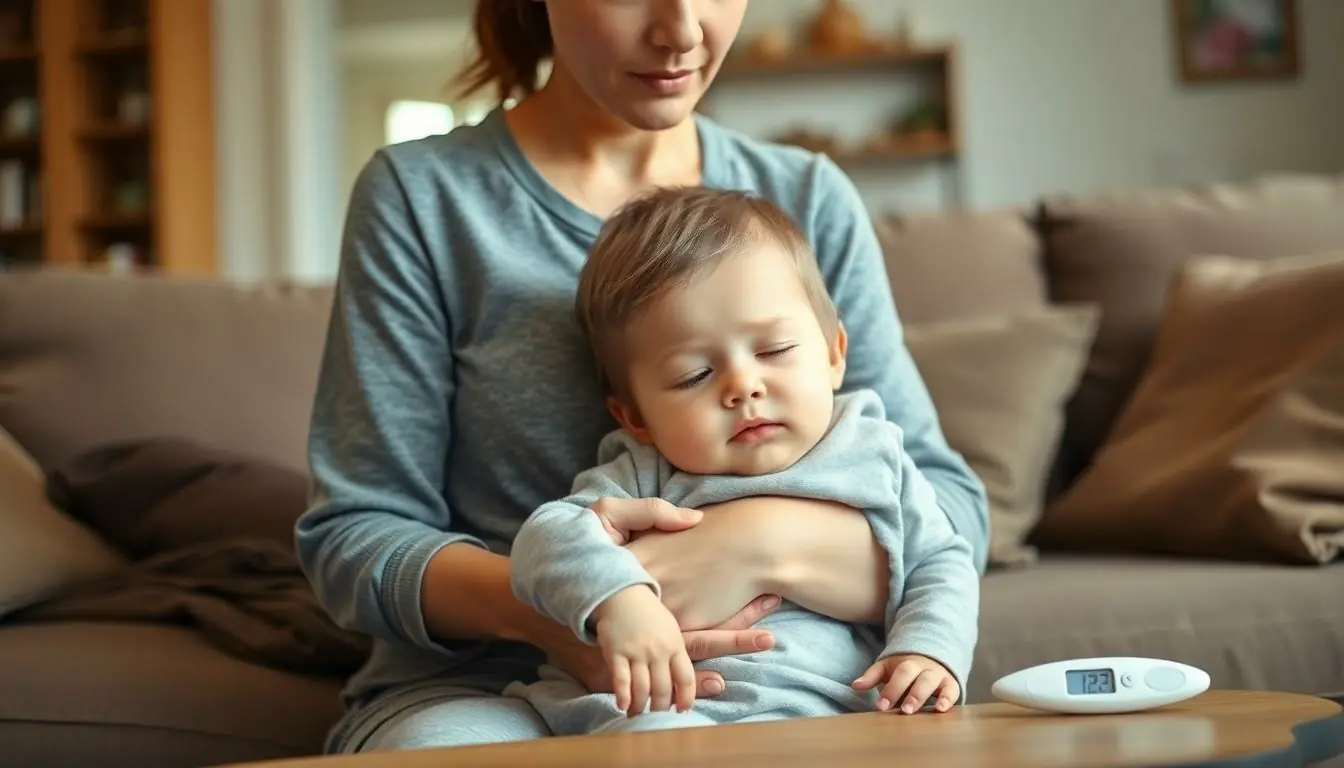When a toddler’s temperature rises, it can feel like the world is spinning out of control. Parents often find themselves in a panic, wondering if they need to channel their inner superhero and rush to urgent care or simply wait it out with a popsicle and a cuddle. After all, toddlers are notorious for turning a minor sniffle into a dramatic production worthy of an Oscar.
Table of Contents
ToggleUnderstanding Toddler Fever
Fever indicates that a toddler’s body is fighting off an infection or illness. Typically, a normal temperature ranges from 97°F to 100.4°F. A fever occurs when the body temperature rises above this threshold. Parents often notice that mild fevers are common, especially during childhood.
Most fevers in toddlers, especially those under three years old, usually aren’t cause for alarm. Body temperatures between 100.4°F and 102.2°F can arise from common illnesses like colds or minor infections. Parents often manage these fevers with fluids and rest.
Severe fevers, defined as temperatures above 102.2°F, may warrant further attention. Signs of distress can include persistent crying, irritability, or lethargy. An urgent evaluation is essential if a toddler exhibits these symptoms alongside a high fever.
Dehydration can become a concern with fever, particularly if a toddler refuses fluids or shows signs of dryness, such as a dry mouth or decreased urination. Parents should monitor drinking habits closely during this time.
Age is an important factor to consider. For infants under three months with a temperature of 100.4°F or higher, immediate medical care is necessary. This age group remains vulnerable to serious infections.
Lastly, persistent fevers lasting more than three days indicate possible underlying issues. At this point, professionals recommend contacting a pediatrician for further guidance. Understanding these parameters helps parents respond effectively to their child’s fever.
Common Causes of Fever in Toddlers

Fever in toddlers often arises from various infections. Identifying the source can help parents determine the appropriate response.
Viral Infections
Viral infections frequently cause fevers in toddlers. These infections include the common cold, influenza, and respiratory syncytial virus (RSV). Parents often observe additional symptoms like runny noses and coughs accompanying the fever. Generally, the fever from viral infections remains mild and resolves on its own within several days. Toddlers typically respond well to supportive care, such as fluids and rest. A notable characteristic of viral fevers is that they usually do not require antibiotics since viruses do not respond to these medications. Monitoring the child closely for signs of dehydration is crucial. If the fever persists beyond three days, further evaluation by a pediatrician may be necessary.
Bacterial Infections
Bacterial infections can also lead to fever in toddlers, often presenting more severe symptoms. If a toddler has ear infections, strep throat, or pneumonia, fever commonly occurs. Symptoms like intense pain, high fever, and irritability often signal bacterial issues. Antibiotics usually treat these infections effectively, and quick medical assessment is important. The fever might rise above 102.2°F, making prompt intervention essential. In such cases, parents should seek medical care, especially if the child shows signs of lethargy or persistent discomfort. Recognizing these patterns in bacterial infections aids in ensuring timely treatment and reduces the risk of complications.
Signs That Indicate Urgent Care
Recognizing when to seek urgent care for a toddler’s fever is essential. Certain signs suggest immediate evaluation is necessary.
High Fever Thresholds
A temperature above 102.2°F in toddlers signals potential concern. Such high fevers often indicate severe infections or illness. If the fever persists despite comfort measures like fluids and rest, parents should consider emergency care. Immediate medical attention is crucial if the fever remains elevated for more than a few hours, particularly if a toddler appears lethargic, inconsolable, or displays unusual irritability. Act quickly to ensure the child’s safety.
Persistent Symptoms
Fever lasting more than three days warrants medical evaluation. Accompanying symptoms such as difficulty breathing, rash, or excessive vomiting further emphasize the need for urgent care. If a toddler experiences body stiffness or continuous crying, these signs may indicate a serious condition. Monitoring symptoms closely helps in determining the right moment to seek pediatric evaluation. Immediate attention can prevent complications and provide peace of mind for caregivers.
When to Wait and Monitor at Home
Fever in toddlers often calls for careful monitoring before deciding on urgent care. Parents can manage mild symptoms effectively at home with appropriate strategies.
Home Remedies for Mild Fever
Resting may significantly help toddlers recover, as sleep promotes healing. Parents can provide fluids like water and electrolyte solutions to prevent dehydration. Applying a damp washcloth to the forehead can also enhance comfort. Keeping the room cool supports temperature regulation without additional medication. Offering popsicles or chilled foods might entice toddlers to hydrate. Generally, reassuring cuddles and quiet activities contribute positively to a child’s emotional well-being during this time.
When to Reassess Symptoms
Reassessing symptoms proves essential as fever persists. Parents should consider consulting a pediatrician if a toddler’s temperature remains elevated after several hours. Increased irritability, difficulty in waking, or persistent crying often signals the need for re-evaluation. If the toddler develops new symptoms like difficulty breathing, rash, or excessive vomiting, prompt medical attention becomes necessary. Parents should monitor hydration closely. Watching for signs of lethargy also aids in gauging the situation effectively. Overall, understanding these indicators helps caregivers make informed decisions about seeking further care.
Deciding when to take a toddler to urgent care for a fever can be challenging for parents. It’s vital to stay vigilant and monitor symptoms closely. Recognizing when a fever exceeds 102.2°F or persists despite home care is crucial. Parents should trust their instincts and seek medical attention if their child shows signs of distress or dehydration.
By understanding the difference between mild and severe fevers and knowing when to act, caregivers can ensure their little ones receive the appropriate care. Ultimately, being proactive about a toddler’s health can lead to better outcomes and provide peace of mind during stressful moments.
